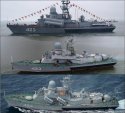Are anti-ship missiles able to execute manoeuvers to dodge enemy Anti-air missiles?
Yes.
What do you think of the speed versus Steath dilemma on the topic of AsHm?
Speed and stealth to some degree are complementary. The faster the missile has to fly, the finer its shape has to be, and that means sharper angles. Something like a DF-17 will likely have lower head on RCS than a subsonic CJ-10 which has a more blunt and rounder shape around the nose.
Speed and stealth --- if you are referring to as sea skimming subsonics --- are not exclusive to each other. The reason why the USN didn't have a supersonic anti-ship missile and concentrated on subsonics, isn't because of a stroke of tactical genius, but is because of politics and budget cutting. The USN was developing Sea Dragon, which was an antiship supersonic missile. That was cancelled because the end of the Cold War kind of meant they were redundant. Now it seemed the project may have been revived in secret but Chinese hackers manage to discover it.
The USN is also considering using the SM-6 as a quasi antiship missile. SAMs can be programmed to hit ships. Like an aircraft, a ship is after all, something that is reflecting radar for the seeker to home in. Beyond that, they're looking at a "joint" missile that can be used as both anti-ship and anti-air. This is likely to be supersonic. This also gives me the idea of the potential the HHQ-9 can be turned into a quasi antiship missile. Its warhead size is nearly that of a YJ-83.
While the Russians are best known for their supersonic antiship missiles, they also have subsonics. The best example is the Kh-35 Uran, which has an awesome code name for it --- Switchblade. That's comparable to the USN Harpoon, European Exocet and the Chinese YJ-83.
Then we get to the Chinese, who has supersonics like the Moskit, the YJ-12 and the YJ-18, in addition to ASBMs which we will put in the hypersonic range But they still have a ton of subsonics, perhaps more in fact. J-15s launch the YJ-83, Z-9s can launch the YJ-9. Every Type 054A frigate, with 30 of them, can launch 8 YJ-83. There are over 60 to 80 Type 022 FAC, each with eight YJ-83. Over sixty Type 056 and 056A is capable of launching four YJ-83 each. There are also the six Type 052C that carries eight YJ-62 each. A YJ-62 is a subsonic antiship missile that is derived from a land based cruise missile, and its very similar to the DH-10 or CJ-10. In other words, this is like the Chinese Tomahawk antiship missile (TASM).
I don't think it would be hard for China to come up with missiles with greater stealth. JASSM like missiles were already shown at Zhuhai and the LRASM was derived from the JASSM. I can see at least three kinds that may pop up. The first is a possible YJ-83 replacement for smaller ships and would use the same slanted launcher. The second is something that can be launched from the U-VLS. The third is air launched including types that can be launched from helicopter or drone. If they are planning to use GJ-11 as an attack drone, you bet they're going to use stealthy air to surface weapons with it.
Lastly the YJ-18 is by itself a hybrid of a subsonic sea skimmer and the supersonic missile. In transit, this is a subsonic sea skimmer flying low to avoid detection, then as it approaches its target, it fires its rocket based second stage, which completes its final and terminal stage of flight. The problem of intercepting this missile is that it's supersonic at a very low sea skimming height, and it conducts evasive maneuvers on top of that. This isn't like the ramjet powered supersonic that requires a certain altitude to cruise, making it detectable on its cruising stage and puts a limit to the minimum altitude at the final or terminal stage of flight. None of the supersonic target drones used in the West has this flight profile; the Coyote is a ramjet that can be used to mimic the flight characteristics of the Oniks, Moskit, Kh-31 or YJ-91, and the YJ-12, but not the YJ-18 or its Russian counterpart, the 3M-54.






